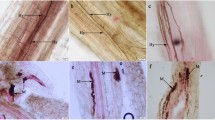Summary
The survival of Azolla was studied in an artificial system which simulated the soil/water interface and the desiccation of soil during a fallow period in lowland rice culture. Tests with non-sporulating and sporulating Azolla fronds showed that Azolla only survives with sporulated fronds. At their reappearance the Azolla fronds already harboured the Anabaena endophyte. A detailed light microscopic and transmission electron microscopic study of macro- and micros-porocarp formation and development revealed that the endophyte is transmitted by the macrosporocarps and not by the microsporocarps. The Anabaena cells within the macrosporocarps are found just below the indusium cap. These cells are not nitrogen-fixing akinetes. The free-living Anabaena cells at the stem apex and below the overarching developing leaves do not bear heterocysts and accordingly are non nitrogen-fixing. During the development of the leaf the Anabaena enters the leaf cavity, but later the pore of this, cavity closes and the imprisoned cyanobacteria are lysed before the leaf decays. As the Azolla leaves age a nitrogen-fixing capability is successively built up concomittantly with the production of heterocysts. Heterocyst frequencies of 40–50% can be found inAnabaena azollae. Usually a gradient of nitrogen-fixing capacity occurs along the Azolla rhizome with two distinct peaks at leaf number 7/8 and at leaf number 13/14 from the apex.
Similar content being viewed by others
References
Ashton P J and Walmsley R D 1976 The aquatic fernAzolla and itsAnabaena symbiont. Endeavour 35, 39–43.
Becking J H 1975 Nitrogen fixation in some natural ecosystems in Indonesia.In Symbiotic Nitrogen Fixation in Plants. Ed. P S Nutman, Cambridge University Press, pp 539—550.
Becking J H 1979 Environmental requirements ofAzolla for use in tropical rice production.In Nitrogen and Rice, Publ. International Rice Research Institute, Los Baños Laguna, Philippines, pp 345–373.
Becking J H and Donze M 1981 Pigment distribution and nitrogen fixation inAnabaena azollae. Plant and Soil 61, 203–226.
Campbell D H 1893 On the development ofAzolla filiculoides Lam. Ann. Bot. 7, 155–187.
Duncan R E 1940 The cytology of sporangium development inAzolla filiculoides. Bull. Torrey Bot. Club 67, 391–412.
Goebel K 1905 Organographie der Pflanzen. English ed. Translated by I B Balfour, Part 2, Oxford, Oxford Univ. Press 707 pp+417 figs.
Goebel K 1930 Organographie der Pflanzen, insbesondere der Archegoniaten und Samenpflanzen. Vol. 2, Teil II, Dritte, umgearbeitete Auflage, Jena, Verlag Gustav Fischer, 1103–1362.
Hanning E 1911 Über die Bedeutung der Periplasmodien. Flora 102, 210–278.
Karamyshev V P 1957Azolla as a fertilizer for rice (in Russian). Nauka i peredovoi opyt v sel’skom Khozyaistve 7(10), 75–77.
Konar R N and Kapoor R K 1974 Embryology ofAzolla pinnata. Phytomorphology 24, 228–261.
Li Zhuo-Xin 1982 Nitrogen fixation byAzolla in rice fields and its utilization.In Non-symbiotic Nitrogen Fixation and Anorganic Matter in the Tropics, Symposia Papers: 12th International Congress of Soil Science, New Delhi, India, Febr. 8–16, 1982, pp 83–95.
Lucas R C and Duckett J G 1980 A cytological study of the male and female sporocarps of the heterosporous fernAzolla filiculoides Lam. New Phytol., 85, 409–418.
Pfeiffer W M 1907 Differentiation of sporocarps inAzolla. Bot. Gaz. 44, 445–454.
Rao H S 1936 The structure and life-history ofAzolla pinnata R. Brown with remarks on the fossil history of the Hydropterideae. Proc. Indian Acad. Sci. 2, 175–200.
Shen E Y 1960Anabaena azollae and its hostAzolla pinnatta. Taiwania 7, 1–7.
Singh P K 1977 Multiplication and utilization of fern ‘Azolla’ containing nitrogen-fixing algal symbiont as green manure in rice cultivation. Il Riso 26, 125–137.
Strasburger E 1873 Über Azolla, Hermann Dabis Verlag, Jena, Germany, 86 pp+Tafel I–VII.
Watanabe I, Espinas C R, Berja N S and Alimagno B V 1977 Utilization of theAzolla-Anabaena complex as nitrogen fertilizer for rice. IRRI Research paper series, No 11, 15 pp.
Author information
Authors and Affiliations
Rights and permissions
About this article
Cite this article
Becking, J.H. Endophyte transmission and activity in the Anabaena-Azolla association. Plant Soil 100, 183–212 (1987). https://doi.org/10.1007/BF02370941
Issue Date:
DOI: https://doi.org/10.1007/BF02370941




